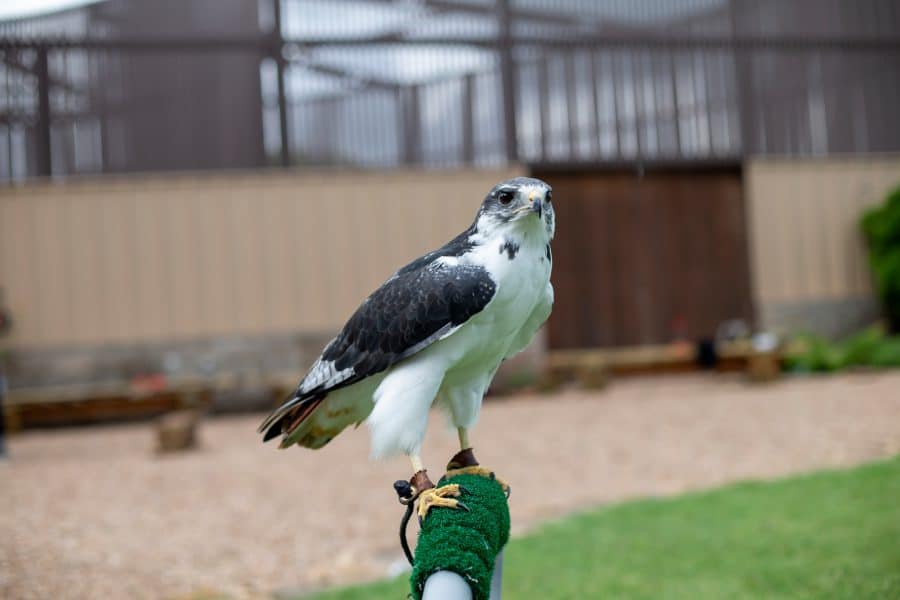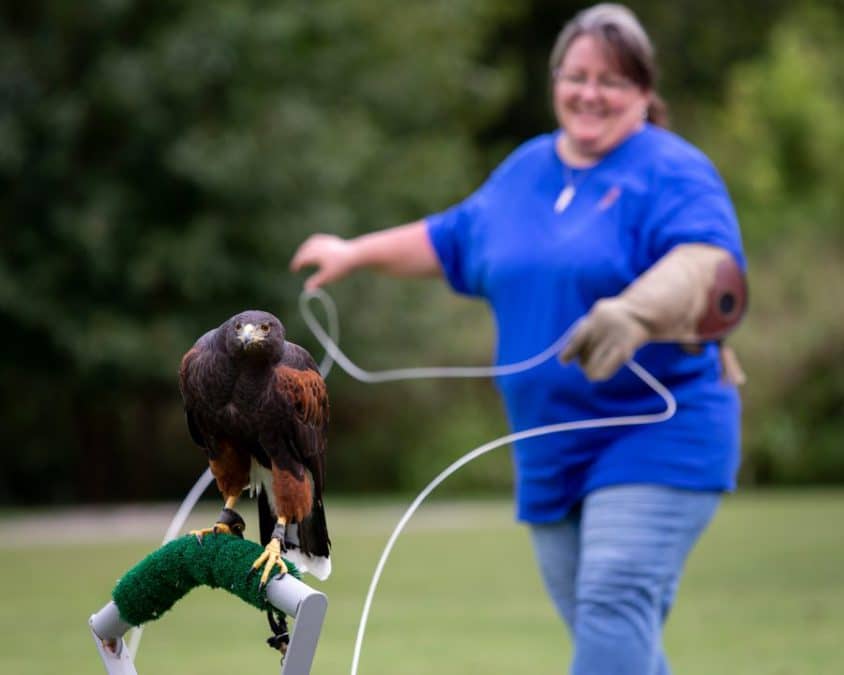While the Citizen Potawatomi Nation Eagle Aviary houses both injured bald and golden eagles that cannot return to the wild, other birds of prey also call the aviary home. All residents are raptors, and they share similar sharp, hooked bills and strong talons. These birds of prey also all pursue other animals as their food source.
“The term raptor is derived from the Latin ‘raptare,’ which means ‘to seize and/or capture,’” explained CPN Aviary Manager Jennifer Randell. “Hawks, eagles, owls, osprey, vultures and falcons are all considered raptors even though they have a greatly varied prey base and hunting style.”

The aviary is proud to care for three non-eagles including an augur buzzard named Nikan, a peregrine falcon named Lady Z and Jigwé, a Harris’s hawk.
Ecological importance
“These birds are part of our education program and help us educate people about conservation and the importance of raptors in the environment and our connection to them,” Randell said. “Having a diverse group of education birds gives people an opportunity to see and appreciate more than just eagles.”
Historically, hawks and other birds of preys’ roles were not understood, and former ecological policies encouraged killing these key predators due to their natural behaviors. When in the wild, these birds help signal an ecosystem’s overall health, and scientists often refer to raptors as an indicator species.
“Birds of prey are apex predators at the top of the food chain and are extremely sensitive to many environmental changes in an ecosystem because they depend on a balance of wildlife as a prey base to support them,” Randell said.
Pesticides and other chemicals build up in our ecosystems, becoming more and more concentrated with each step up on the food chain.
“Researching the population trends of raptors provides a cost-effective and efficient means to detecting environmental change, allowing us to take conservation action that is driven by the latest scientific data,” she explained.
They also help control populations of rodents and other small mammals, but for many years, management approaches ignored the importance birds of prey hold. In the past, the public often blamed them for threatening farm animals.
“While it is true larger eagles may take young livestock like a lamb, we forget that the rancher displaced their natural food source when they introduced livestock,” Randell said.
DDT and similar chemicals used in high levels can cause birds’ eggshells to become thin and brittle; as a result, the frail eggs do not survive incubation. The aviary’s work helps with conservation efforts. Through education, the aviary aims to decrease human’s negative impact on all animals, especially birds of prey.

Nikan, Lady Z and Jigwé
The aviary’s augur buzzard Nikan is the younger brother of Dots, one of the first birds the aviary took into its care.
“Shortly after Dots walked on, we were made aware that his little brother needed a good home,” Randell said. “Having an augur buzzard works out great for education. He was hatched here in the U.S., but augur buzzards are native to Africa and are like a cousin to our red-tailed hawks.”
Although augur buzzards and red-tail hawks come from other sides of the world, they share related diets, habitats and have similar markings. Instead of being brown and cream like the red-tail hawk, augur buzzards are white and grey.
Before arriving at the CPN Aviary, Nikan had some behavioral issues and was not comfortable enough to act on his natural instincts. This instantly changed once he arrived in Oklahoma; he calmed and starting nest building and bonding with the aviary staff.
Jigwé and Lady Z both started nesting for the first time. Before opening the aviary, CPN’s Randell and Dunham trained with staff at, Sia: The Comanche Nation Ethno-Ornithologocial Initiative, where they became acquainted with Lady Z and Jigwé.
“They both are dominant females and are sure they run the show. For the most part, they are correct,” Randell said. “We love that they are a little spunky and give them that space and time to go through nesting. They both seem content to incubate eggs, and someday maybe they will have the opportunity to be foster parents.”
Although they hold similarities, each raptor is unique and requires specific care.
“From diet to perching, they are all a little different,” Randell said. “Winter months, Nikan spends his time in an enclosure that is heated because he is not from this hemisphere, and although he is acclimated to our climate, we prefer to be safe, and he seems to enjoy his warm enclosure.”
Lady Z loves spending time on a high perch, that way she can keep an eye on all of those who enter and leave her space.
“In many areas out west, where they are found, they nest on tall cactus,” Randell said of the peregrine falcon. “They hunt together, will nest cooperatively, and nests may be tended by more than two adults. So they are very social, and she needs to have that interaction.”
Jigwé, the Harris’s hawk at the CPN aviary, is more private than her counterparts are, and because of the long nature of her feet, she prefers a flat perch to a rounded one like the aviary’s other residents.
“She’s very vocal and territorial during nesting season, and we take extra care to give her privacy. So, many months of the year, she does not go out for presentation,” Randell said.
CPN Aviary staff look forward to the chance to educate CPN members and the public on the impact birds of prey have on our livelihood.
“We have a responsibility to care for these raptors, acting as ambassadors to help educate and hopefully inspire others about conservation and how we can be good stewards of our lands and those that we share it with,” Randell said. “They are a vital part of our ecosystem and our family. Sharing that with others helps to reconnect our people to the living eagle and other raptors.”
For more information on the CPN Eagle Aviary, visit potawatomiheritage.com.
